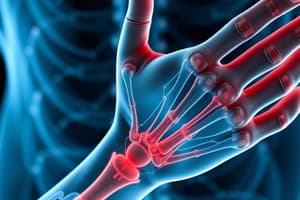Podcast
Questions and Answers
What is the primary mechanism by which IVIG infusions help in the treatment of Guillain-Barre syndrome?
What is the primary mechanism by which IVIG infusions help in the treatment of Guillain-Barre syndrome?
- IVIG infusions block the signals that trigger the patient's immune system to attack their own nerve cells.
- IVIG infusions stimulate the patient's own immune system to produce more healthy antibodies.
- IVIG infusions introduce new antibodies that directly attack the damaging antibodies. (correct)
- IVIG infusions provide additional oxygen and nutrients to the patient's nerve cells.
What is the primary purpose of performing a lumbar puncture in the diagnosis of Guillain-Barre syndrome?
What is the primary purpose of performing a lumbar puncture in the diagnosis of Guillain-Barre syndrome?
- To check the patient's cerebrospinal fluid protein levels (correct)
- To detect the presence of any tumors or lesions in the spinal cord
- To assess the patient's muscle strength and reflexes
- To measure the patient's nerve conduction velocity
Which of the following is NOT considered a key feature that can support the diagnosis of Guillain-Barre syndrome?
Which of the following is NOT considered a key feature that can support the diagnosis of Guillain-Barre syndrome?
- Rapidly evolving symptoms
- Recent infection
- Absence of fever
- Elevated body temperature (correct)
Which of the following factors can influence the recovery timeline for a patient with Guillain-Barre syndrome?
Which of the following factors can influence the recovery timeline for a patient with Guillain-Barre syndrome?
What is the primary role of rehabilitation therapies, such as occupational and physical therapy, in the recovery process for patients with Guillain-Barre syndrome?
What is the primary role of rehabilitation therapies, such as occupational and physical therapy, in the recovery process for patients with Guillain-Barre syndrome?
Which of the following is not considered a common symptom or characteristic of Guillain-Barre syndrome?
Which of the following is not considered a common symptom or characteristic of Guillain-Barre syndrome?
Which of the following is NOT a potential trigger for Guillain-Barre syndrome?
Which of the following is NOT a potential trigger for Guillain-Barre syndrome?
Which of the following treatments for Guillain-Barre syndrome aims to remove harmful antibodies from the bloodstream?
Which of the following treatments for Guillain-Barre syndrome aims to remove harmful antibodies from the bloodstream?
What is the primary mechanism behind Guillain-Barre syndrome?
What is the primary mechanism behind Guillain-Barre syndrome?
Which of the following is a potential symptom of Guillain-Barre syndrome?
Which of the following is a potential symptom of Guillain-Barre syndrome?
Which of the following statements about the cause of Guillain-Barre syndrome is correct?
Which of the following statements about the cause of Guillain-Barre syndrome is correct?
What is the primary goal of treatment for Guillain-Barre syndrome?
What is the primary goal of treatment for Guillain-Barre syndrome?
Study Notes
Understanding Guillain-Barre Syndrome: Causes, Treatment, and Recovery
Guillain-Barre syndrome (GBS) is a rare autoimmune disorder where the body's immune system mistakenly attacks the protective covering of nerve fibers, called the myelin sheath. This attack disrupts communication between the nervous system and the rest of the body, leading to muscle weakness, tingling, and sometimes paralysis. Here's what you need to know about the causes, treatment, diagnosis, and recovery process for Guillain-Barre syndrome.
Causes
The exact cause of Guillain-Barre syndrome remains unknown, but it typically follows an infection, particularly a viral or bacterial infection in the past few weeks. Likewise, vaccinations against COVID-19, such as the Johnson & Johnson or AstraZeneca brands, can trigger the disease. The immune system mistakenly targets the proteins on the surface of nerve cells, causing damage to the myelin sheath and nerve fibers themselves.
Treatment
Treatment for Guillain-Barre syndrome aims to manage symptoms and prevent further nerve damage. Two primary methods are used: plasma exchange (plasmapheresis) and intravenous immunoglobulin (IVIG). Both approaches help eliminate harmful antibodies in the bloodstream. Plasmapheresis removes the liquid component of the blood (plasma) to reduce the concentration of abnormal antibodies, effectively neutralizing the immune response. On the other hand, IVIG infusions supply the patient's bloodstream with healthy antibodies from blood donors, which compete with the damaging antibodies and protect nerve cells. The choice between these two treatments depends on individual circumstances and may involve consultation with a healthcare provider.
Diagnosis
Diagnosing Guillain-Barre syndrome can be challenging due to its varied symptom presentation and overlap with other conditions. However, key features like rapidly evolving symptoms, absence of fever, recent infection, and certain characteristic findings on electromyography (EMG) and nerve conduction studies can support the diagnosis. Other supportive measures include lumbar puncture to check cerebrospinal fluid protein levels and imaging tests like magnetic resonance imaging (MRI) to rule out other possible explanations.
Recovery
Recovery from Guillain-Barre syndrome varies widely, ranging from a few weeks to several years. Patients often require hospitalization to monitor their condition and receive proper treatment. During recovery, individuals may benefit from rehabilitation therapies, such as occupational and physical therapy, to regain lost motor skills and maintain functional independence. Support from family members, friends, and support groups can also play a crucial role in coping with the challenges of living with GBS.
Studying That Suits You
Use AI to generate personalized quizzes and flashcards to suit your learning preferences.
Description
Test your knowledge on the causes, treatment, diagnosis, and recovery process of Guillain-Barre syndrome, a rare autoimmune disorder affecting the nervous system. Learn about the immune system's role, treatment methods like plasma exchange and IVIG, diagnostic approaches, and the varying recovery timelines associated with GBS.




